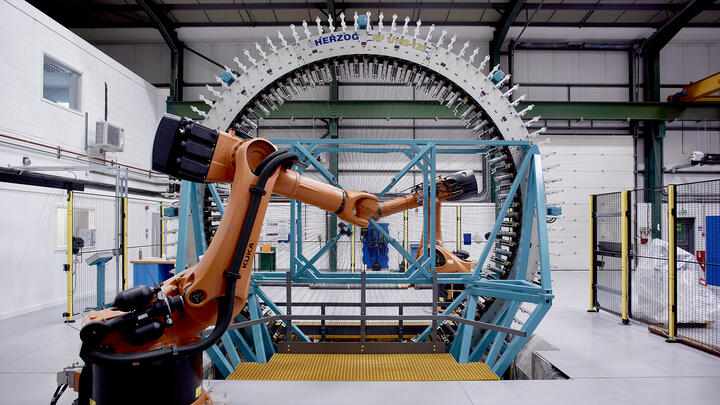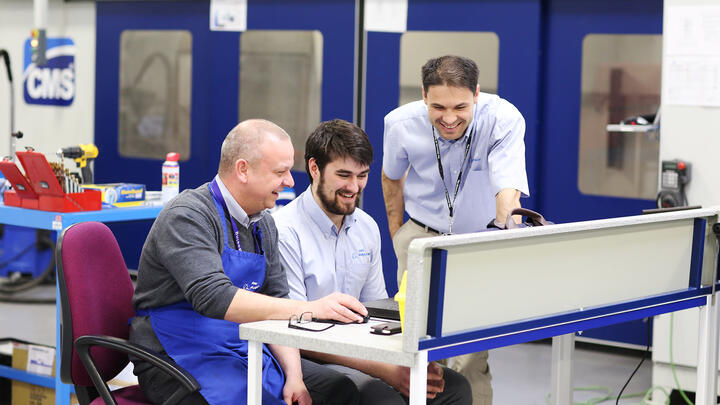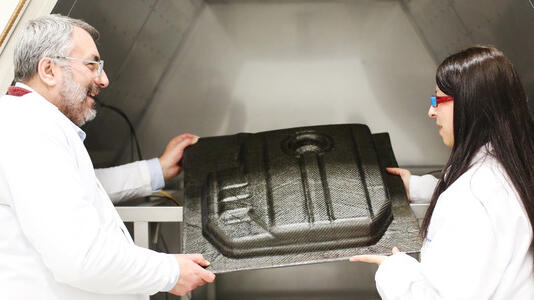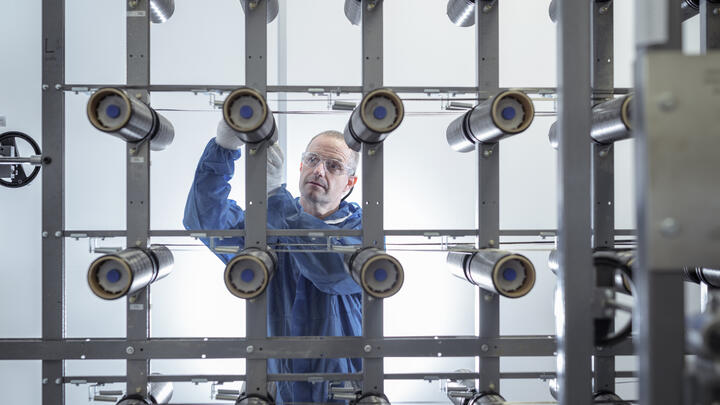AMRC composites: the wonder years and next steps
31 October 2022Composites at the University of Sheffield Advanced Manufacturing Research Centre (AMRC) began life in 2006 as a team of just four, with no workbenches in sight and little more than a laptop to work with. Fast forward to 2022 and it’s now transformed into one of the UK’s most renowned composites teams, with an employee base of more than 50 and boasting some of the best composite technology and machinery in the business.
Article feature in the latest issue of the AMRC Journal.
To mark the centre’s 16-year anniversary, we’re looking back at some of the people who helped make the world of composites at the AMRC the success it is today, from collaborations with global brands such as Boeing and McLaren; to notable highlights and plans for the future.
Dr Clara Frias, who heads up the composites team, said she’s reached the pinnacle of her career after six-and-a-half years at the AMRC. She is a keen advocate for this sector of work, which she describes as ‘beautiful’ and wants to push composites to the forefront of UK manufacturing in any way possible.
“Composites to me, means a lot in many different ways and is a job I am very passionate about,” Clara said. “Each day is different and the impact we’ve been making in the industry means a lot to our team. I believe that success in this industry is all about taking on a team approach.
“Our unique, multi-cultural workforce pulls together vital knowledge from both industry and academia. Everyone has a passion to deliver new and unique composite techniques and we’re always on the lookout for that next big challenge. I feel extremely lucky and proud to work in composites and believe we have some of the best engineers and researchers in the business.”
In 2006, six years after the AMRC was first formed by Prof Keith Ridgway, John Baragwanath and local businessman Adrian Allen, with backing from the University of Sheffield and Boeing, composites began in Vector 31, an interim facility close to the AMRC, housed in a then new warehouse on an emerging industrial estate in a small village between Rotherham and Sheffield.
It’s a world away from today’s fully equipped composites arm of the AMRC housed within a dedicated extension of Factory of the Future (FoF), which was built in 2012 and sits on the Advanced Manufacturing Park in Rotherham. Composite centre research engineers work to solve manufacturing challenges across a range of sectors and businesses from aerospace, automotive and energy to hydrogen pressure vessels and deepsea recovery.
Engineers Conrad Sdao and John Halfpenny formed part of the initial team brought in to the AMRC to start a composites offer. Conrad and John, who joined the AMRC just months apart, brought with them a strong composites background, with the pair having previously worked together for a small composite firm in Derby, which supplied Formula One team parts and automotive composite components.
Conrad, the AMRC’s composites factory manager, said it was the ‘lure of research and development’ with the likes of Boeing that got him interested in working for the AMRC.
“Over the years, I’ve done a bit of everything in the centre, from project kick-off meetings, buying machines and materials to health and safety, as well as overseeing the three sites where our equipment is based,” he said.
“For me, the best parts of the job are that no one day is ever the same and having come from an apprentice-led background myself, it’s great to be able to work with such a talented set of engineers, being able to pass on my experience to them and to watch them grow during their careers at the AMRC. To say that we started with nothing, it really is amazing to see how the composites capabilities at the AMRC have grown over the years and the amount of equipment we now have.”
John, who is the composite technical lead for the manufacturing side of the team, recalls what it was like to work at the AMRC in the early years.
“When I started, there were only four people working on just one project, an integrated wing landing gear component which was led by company Messier Dowty, working together with Airbus and other project partners,’’ he said.
“Most of the work we did, we had to ‘sub contract’ to local composite manufacturing companies, the AMRC was still in the process of purchasing new equipment, all we had were basic laptops and not a workbench in sight.
“An aerospace company, Boeing, were keen for us to do composites research for them, which helped push forward with our overall AMRC composites offer. Over the years, we’ve gone from working on one, two, three and four projects at a time to now having about 50.” John said his favourite part of the job is making the composite components and seeing them come to fruition, which can sometimes take up to one or two years, and showing these completed components to the rest of the team who worked on them too.
In 2008, Richard Scaife was employed by the AMRC as head of the composite centre to help commercialise the composites capabilities of the AMRC, make active partnerships, create collaborative working relationships as well as making it financially viable for the future.
Richard, who is now regional development director for the AMRC, said: “Part of my job role was to install equipment and get everything set up and started, which was a very exciting prospect. I worked with Keith Ridgway for 18 years - he brought me to the AMRC. He was looking for someone to come in and make the composite centre happen and we literally had to start from scratch with no track record.
“Ridgway, Baragwanath and Allen were integral to the success of the composites centre proposition and its creation. Working with Emma Hutton, the then projects development manager, funding applications were made and approved, enabling the purchase of equipment, a new factory and funding for staff and associated costs.
“Our talented pool of engineers and our ability to engage with industry in a manner where we can develop industry-relevant solutions on industrial timescales is what makes our composites offer great – and I have never encountered such diversity in one sector as we pull from chemistry, physics, materials, textiles, research and academia.”
Jody Turner, composites technical lead, started at the AMRC in 2009 and recalls the big move the composites team made in 2012 from the AMRC’s Design Prototyping and Testing Centre (DPTC) to Factory of the Future. It happened while Jody was on maternity leave and she remembers how daunting it seemed and that it felt like she was starting a new job from scratch.
“Another revolutionary year for composites came in 2014 when the opportunity opened up for us to get involved with the textile side of composites preform manufacture; we got our first bit of textiles kit, the 2D weaving machine,” Jody said. “It was a completely new and exciting avenue for us to explore. Later in 2018, we also acquired a raft of new machinery in the forms of a 3D weaving machine, a braiding ring and a tailored fibre placement machine - these pieces of equipment were a game-changer for our dry-fibre technology research.” Jody says the AMRC is a fantastic place to work, and the composites team has ‘a real family feel to it’. Her favourite part of the job is the hands-on work they get to undertake.
With 16 successful years under its belt, composites at the AMRC is going from strength-to-strength, says Clara, who is excited for the future that lies ahead. “Compared with when I first started at the AMRC six-and-a-half years ago, we’ve had a massive growth in our footprint, skills and capabilities – but there is always space to grow and that is always on our minds,” she said.
“Going forward, we are hoping for further big growth that will help us revolutionise the old manufacturing processes and how we break that chain, alongside working through environmental challenges. The UK is a leader in composite technology, and must continue to push the capabilities, research and technologies the AMRC provides so the UK remains at the top of this field in the future, alongside helping to provide a composite legacy the country can be proud of.”




